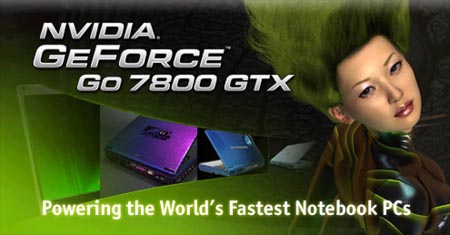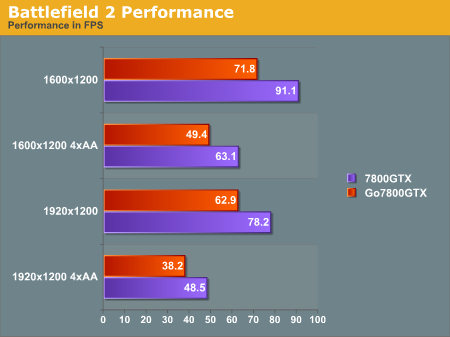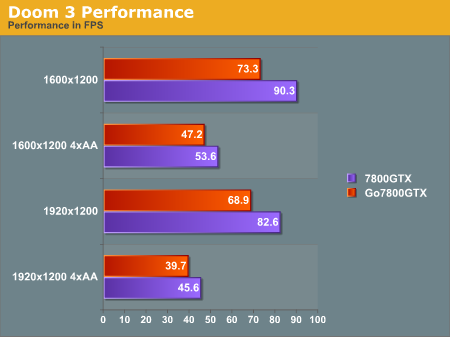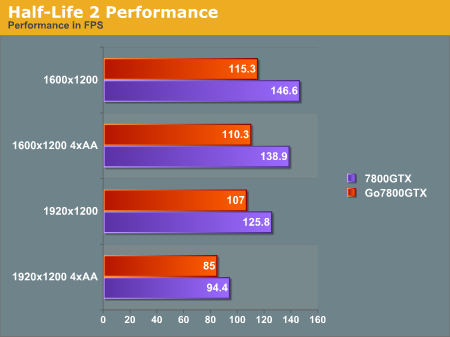
Original Link: https://www.anandtech.com/show/1815
Hypersonic Aviator EX7: NVIDIA GeForce Go 7800 GTX First Look
by Josh Venning on October 10, 2005 9:30 AM EST- Posted in
- GPUs
Introduction
When thinking about the ideal gaming system, your first choice probably wouldn't be a laptop. It's common sense that desktop systems are better suited to meet the requirements needed for serious gaming. Lately though, we've been seeing some notebook systems that try to tackle this preconception, with interesting results. One of these systems, made by Hypersonic, does the job very well. While it is an excellent laptop, one part on the inside really caught our attention.
Any gaming system needs a good graphics card, and if you were thinking about the most powerful one right now, you'd be thinking about NVIDIA's 7800 GTX. (The X1800 XT might surpass it, but it will be another month before you can purchase such cards.) We've reviewed many of these cards and given their huge power draws, high heat levels, and generally monstrous size (for a graphics card), the thought of one of these cards in a notebook would have seemed a bit ludicrous. But it looks like NVIDIA has managed to fit one in there with their mobile version of the card, the GeForce Go 7800 GTX.

The system that we're reviewing is the Hypersonic Aviator EX7, and it appears to be the most powerful gaming notebook on the market at this time. The GeForce Go 7800 GTX does differ slightly from its desktop counterpart, and we'll be talking about those differences in the next section. We'll also be looking at some performance test results to give us a better idea of how the Go 7800 GTX compares with a normal 7800 GTX. Rest assured, the Go 7800 GTX lives up to its name and the results are impressive indeed.
Notebook gaming is, by no means, new. Both NVIDIA and ATI have been making quality mobile versions of their most popular parts, which we've looked at in the past. Specifically, the Mobility RADEON X800 XT by ATI and NVIDIA's GeForce Go 6800 Ultra. Now, we have a chance to look at the performance of the mobile version of the 7800 GTX: the most powerful mobile graphics card currently on the market.
The System and The Card
We mentioned earlier that there are some differences between the Go 7800 GTX and the 7800 GTX. The most important difference is the fact that the Go 7800 GTX is clocked slightly lower than a normal 7800 GTX, with a core clock of 400MHz and memory clock of 1.1GHz. Other than that, they are essentially the same, with 8 vertex pipelines and 24 pixel pipelines. The Go 7800 GTX does employ NVIDIA's PowerMiser technology in order to manage heat more effectively than its desktop counterpart, which is a good thing, given the limitations of a notebook in that regard. The power budget given to the Go 7800 GTX is the same as it is for the earlier Go 6800 Ultra.
For testing, we used a Hypersonic Aviator EX7 notebook fitted with a GeForce Go 7800 GTX. Here are its specifications:
P4 670 (3.8GHz)
2 Gigs DDR2-533 CAS4 RAM
2 100 Gig Hard drives striped in RAID 0
1920x1200 17" display
The system is fairly large, as are most notebooks with displays like this. Not only is it very heavy (about 13 lbs), it generates lots of heat and will burn your lap up if you keep it there for very long. That said, it has all the benefits of a mobile system and was made for serious gaming. The Aviator EX7 is easier to transport than even a small form factor system and packs quite a few high powered components.
We are very impressed with Hypersonic's offering. With a 3.8GHz Pentium 4, this system should outperform those other notebooks that run Pentium M parts. The Dell notebook in which the Go 7800 GTX launched for instance supports at most the 2.26GHz Pentium M, which does perform very well, but isn't quite as the desktop 3.8GHz part.
The one complaint that we have about the Hypersonic Aviator EX7 is that it gets incredibly hot. After long hours of operation, the surface on which it sits also gets very warm and just using the keyboard was able to make our palms sweat. Or maybe that was just the incredible performance that we were getting out of the notebook. For those interested in the system, we found it to be very stable when kept well ventilated, and you definitely get what you pay for with this one. We do also like the fact that Hypersonic includes a dead pixel guarantee that ensures your thousands of dollars will not be spent on something less than pleasing to look at.
The desktop system that we used is very similar to the one on which we test most of our graphics cards:
Radeon Express 200 based motherboard
AMD Athlon 64 FX-55 Processor
1 GB OCZ 2:2:2:6 DDR400 RAM
Seagate 7200.7 120 GB Hard Drive
OCZ 600 W PowerStream Power Supply
Now, let's take a look at performance.
Performance Tests
Because we weren't able to physically take the Go 7800 GTX and put it into our desktop system, we can't really compare the laptop and desktop version of the 7800 GTX directly. Instead, we performed tests with the Hypersonic system and compared these numbers with tests from a desktop setup fitted with a normal 7800 GTX.
Since the two systems have differences other than the graphics card (i.e. system RAM, processor speed, processor type, etc.), there will be some variation here, but we can still get a general idea of how well the Go 7800 GTX performs compared to the desktop version. Especially at higher resolutions, we will become more GPU limited than CPU/system limited. With our desktop system using an AMD Athlon 64 FX-55 rather than an Intel part, we can definitely expect that the numbers will favor the desktop system.
When looking at the comparison of the stock 7800 GTX and the Go 7800 GTX, keep in mind that the drop in core clock speed is almost 10% and the drop in memory clock is also almost 10%.



While there is variation between the two systems, the differences that you see in framerates are in large part due to the difference in the clock speeds of the 7800 GTXs. You can see from the graphs that for the most part, the difference in framerates between systems are consistent, with the exception of Half life 2, which isn't too surprising given the fact that it's a little more CPU limited than the other 2 games.
In Battlefield 2, we see about a 20%-23% decrease in performance with the Go 7800 in each of the settings. Half life 2 sees about a 22% decrease in performance at 1600x1200 with and without AA, but only a 15% decrease at 1920x1200 without AA, and about 10% at the same resolution with AA. Doom 3 decreases in performance with AA enabled at both resolutions by around 12% on the Go 7800 GTX, and around 18% without AA.
Overall, Battlefield 2 did the worst of these three games on the Hypersonic system, but even at 1920x1200 with 4x AA enabled, it still achieved 38.2 fps, which is playable. Most gamers wouldn't be too upset about either turning off AA at that resolution or going down in resolution (especially if in a notebook with a smaller panel). Doom 3 is only slightly better with 4xAA, while Half-Life 2 has no trouble at all with AA enabled at 1920x1200 resolution.
The bottom line is you do sacrifice some performance going with the mobile 7800 GTX instead of the standard one, but not an incredible amount. Again, we're talking about a notebook here and this one surpasses most great gaming desktops, truly earning the label of a "desktop replacement".
Final Words
Overall, what we have here is a very impressive mobile gaming part. Those looking for the highest performance in notebook gaming need not look any further than this. NVIDIA's GeForce Go 7800 GTX, while not quite as fast as the standard version, still lives up to its name and handles the native 1920x1200 resolution with ease, even with 4x AA enabled. This will make any unit that is fitted with one attractive to those who want a complete and compact package, offering the power that they need to run any game at the highest settings. While the limited battery life that you'll probably experience in a laptop like this is a drawback (these types of systems usually only have 1 or 2 hours of battery life), the portability factor makes it ideal for LAN parties, and it will be sure to impress, regardless of your gaming abilities. But with prices that can get as high as $5,000, you'll be paying top dollar for the performance.
The Hypersonic Aviator EX7 is one of the best laptops that you can buy for gaming right now, but many companies who offer desktop replacement laptops will most likely offer a version fitted with a Go 7800 GTX. With the Hypersonic, we were very pleased at how all of the games ran smoothly at even the highest settings, so you definitely wouldn't be disappointed with the performance of this card. Some people might not like the fact that it's not clocked quite as high as the normal version, and due to obvious reasons (heat, etc.), the card can't really be overclocked. But because most laptops don't incorporate screens larger than 1920x1200 and no games are going to truly bring the Go 7800 GTX to its knees at this resolution, there's not much else right now which would require you to do so.
It's interesting to note that in the past, ATI has generally been the leader in mobility parts over NVIDIA. Since the Go 6800 Ultra hit the scene (and the rest of the mobile 6 series line up), NVIDIA has been gaining ground in performance and desirability. We're curious to see how ATI will respond to the Go 7800 GTX, as this looks like yet another major blow from NVIDIA. Especially considering the fact that NVIDIA had availability of a mobile part the day it launched from multiple vendors including Dell and Hypersonic. ATI couldn't even pull that off with a desktop product launch.
At the same time, as we've seen with Intel hardware, leaner hardware with high clock speeds tend to scale less forgivingly with power than wider architectures with a lower clock speed. We are very interested to see if ATI will be able to drop anything like their 625 MHz X1800 XT into a notebook without melting the plastic casing. Power draw on the high end part is higher than their previous generation, and won't likely fit into the same TDP envelope as the X850 XT as easily as the Go 7800 GTX does.
But this industry is all about surprises, and we won't count out ATI until we see hardware. Of course, no matter how good their hardware is, the longer they take to bring a mobile part to market, the more ground they will lose.







